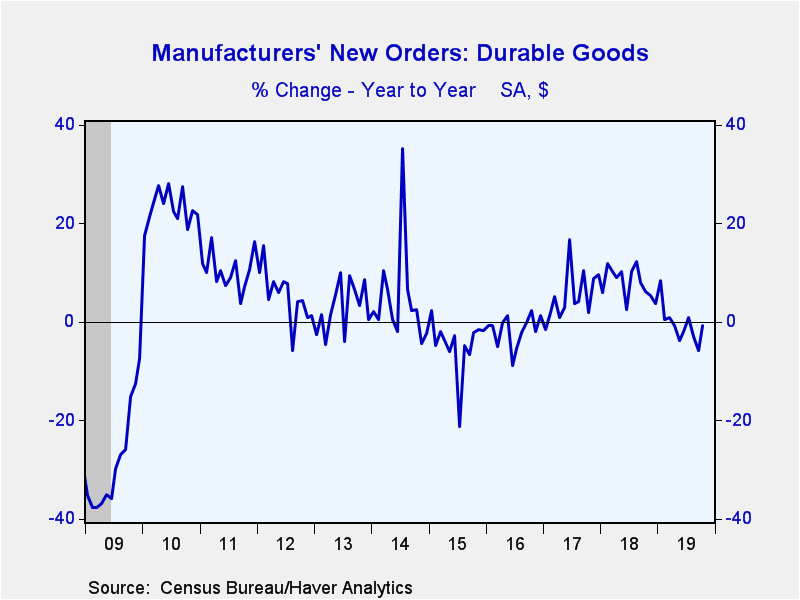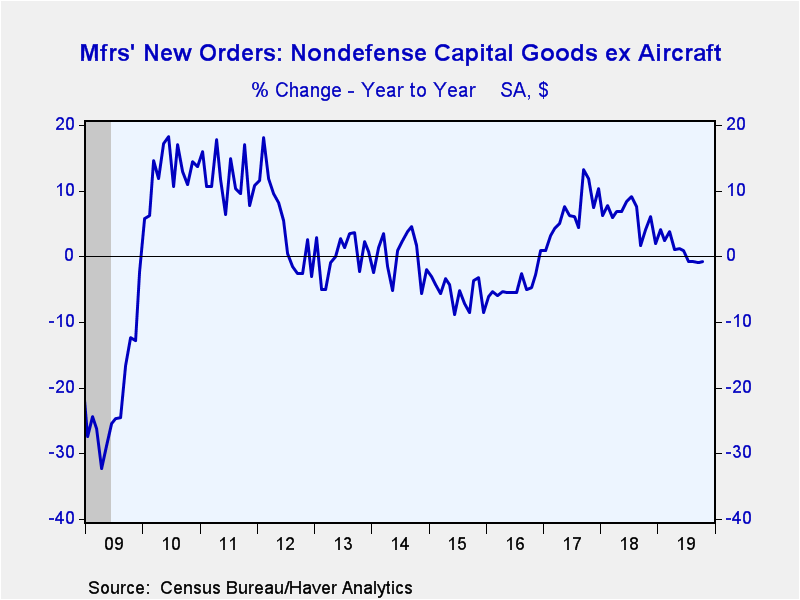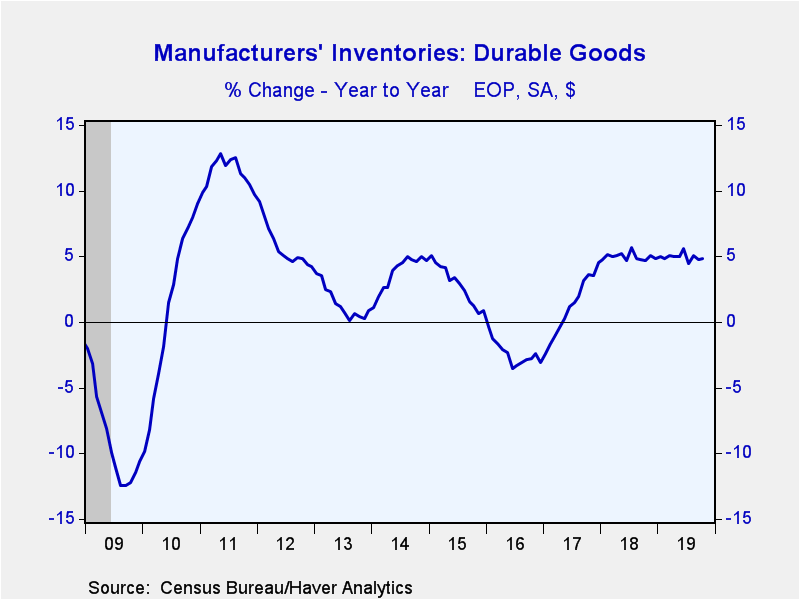 Global| Nov 27 2019
Global| Nov 27 2019U.S. Durable Goods Orders Surprise to Upside in October
by:Sandy Batten
|in:Economy in Brief
Summary
Manufacturers' orders for durable goods unexpectedly rose 0.6% m/m (-0.7% y/y) in October following a downwardly revised 1.4% m/m decline in September. The Action Economics Forecast Survey had anticipated a 0.7% m/m decline for [...]
Manufacturers' orders for durable goods unexpectedly rose 0.6% m/m (-0.7% y/y) in October following a downwardly revised 1.4% m/m decline in September. The Action Economics Forecast Survey had anticipated a 0.7% m/m decline for October. Orders for nondefense capital goods excluding aircraft, a key indicator of business investment plans, jumped up a much larger-than-expected 1.2% (-0.8% y/y) in October after having fallen in each of the previous two months. Shipments of nondefense capital goods excluding aircraft, a good indicator of current business capex, rose a solid 0.8% m/m (+0.4% y/y) in October after having fallen for four consecutive months.
While the October rebound in durable goods orders was relatively widely spread, a 7.2% m/m rise in orders for defense goods provided a lot of the boost. Orders excluding defense orders edged up 0.1% m/m (-2.5% y/y) in October. Transportation orders rose 0.7% m/m (-1.4% y/y) with orders ex. transportation increasing 0.6% m/m (-0.4% y/y) in October. Orders for aircraft and parts jumped up 14.1% m/m in October after declines in both September and August with double-digit rises in both defense and nondefense. The GM strike again took its toll on the auto sector with orders for motor vehicles and parts falling 1.9% m/m (-3.7% y/y) in October on top of a 2.9% m/m decline in September.
Orders outside of the transportation sector were mixed in October. Orders for primary metals orders fell 1.4% m/m (-6.4% y/y) and orders for electrical equipment declined 1.7% m/m (+0.8% y/y). In contrast, orders for fabricated metals increased 1.8% m/m (+2.2% y/y), orders for machinery rose 1.3% m/m (-2.0% y/y), and orders for computers and electronic products gained 0.7% m/m (-1.3% y/y).
Durable goods shipments were essentially unchanged (-1.5% y/y) in October after having declined in each of the previous three months. Transportation shipments fell 0.4% m/m on October. Shipments excluding transportation edged up 0.2% m/m following a 0.1% m/m decline in September. Durable goods inventories increased 0.3% m/m in October, boosted mostly by a 1.3% m/m rise in transportation inventories. Inventories excluding transportation fell 0.1% m/m. Unfilled orders edged up 0.1% m/m, due mostly to a 1.7% m/m jump in unfilled defense orders. Unfilled orders excluding defense fell 0.2% m/m, their third consecutive monthly decline.
The durable goods figures are available in Haver's USECON database. The Action Economics consensus forecast figure is in the AS1REPNA database.
| Durable Goods NAICS Classification | Oct | Sep | Aug | Oct Y/Y | 2018 | 2017 | 2016 |
|---|---|---|---|---|---|---|---|
| New Orders (SA, % chg) | 0.6 | -1.4 | 0.2 | -0.7 | 7.9 | 5.4 | -1.7 |
| Transportation | 0.7 | -3.2 | 0.2 | -1.4 | 9.8 | 3.2 | -0.6 |
| Total Excluding Transportation | 0.6 | -0.4 | 0.1 | -0.4 | 6.9 | 6.5 | -2.3 |
| Nondefense Capital Goods | 3.2 | -3.4 | -3.2 | -3.9 | 5.5 | 9.1 | -5.8 |
| Excluding Aircraft | 1.2 | -0.5 | -0.8 | -0.8 | 6.0 | 6.7 | -4.5 |
| Shipments | 0.0 | -0.7 | -0.2 | -1.5 | 7.1 | 4.0 | -2.3 |
| Unfilled Orders | 0.1 | 0.0 | 0.1 | -1.6 | 3.9 | 1.9 | -1.1 |
| Inventories | 0.3 | 0.5 | 0.3 | 4.8 | 4.8 | 4.5 | -3.0 |
Sandy Batten
AuthorMore in Author Profile »Sandy Batten has more than 30 years of experience analyzing industrial economies and financial markets and a wide range of experience across the financial services sector, government, and academia. Before joining Haver Analytics, Sandy was a Vice President and Senior Economist at Citibank; Senior Credit Market Analyst at CDC Investment Management, Managing Director at Bear Stearns, and Executive Director at JPMorgan. In 2008, Sandy was named the most accurate US forecaster by the National Association for Business Economics. He is a member of the New York Forecasters Club, NABE, and the American Economic Association. Prior to his time in the financial services sector, Sandy was a Research Officer at the Federal Reserve Bank of St. Louis, Senior Staff Economist on the President’s Council of Economic Advisors, Deputy Assistant Secretary for Economic Policy at the US Treasury, and Economist at the International Monetary Fund. Sandy has taught economics at St. Louis University, Denison University, and Muskingun College. He has published numerous peer-reviewed articles in a wide range of academic publications. He has a B.A. in economics from the University of Richmond and a M.A. and Ph.D. in economics from The Ohio State University.










